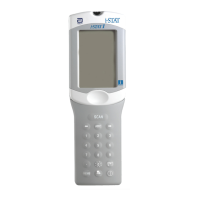TCO2 - 2 Art: 716661-00F Rev. Date: 05-Aug-11
The reference ranges programmed into the analyzer and shown above are intended to be used as guides
for the interpretation of results. Since reference ranges may vary with demographic factors such as age,
gender, and heritage, it is recommended that reference ranges be determined for the population being
tested.
Clinical Significance
TCO
2
is a measure of carbon dioxide which exists in several states: CO
2
in physical solution or loosely
bound to proteins, bicarbonate (HCO
3
) or carbonate (CO
3
) anions, and carbonic acid (H
2
CO
3
). Measurement
of TCO
2
as part of an electrolyte profile is useful chiefly to evaluate HCO
3
concentration. TCO
2
and HCO
3
are
useful in the assessment of acid-base imbalance (along with pH and PCO
2
) and electrolyte imbalance.
Calculated and Measured (Traceable) TCO
2
The calculated TCO
2
provided by the i-STAT System is determined from the measured and reported values
of pH and PCO
2
according to a simplified and standardized form of the Henderson-Hasselbalch equation.
3
TCO
2
= HCO
3
+ 0.03 PCO
2
This calculated TCO
2
measurement is metrologically traceable to the i-STAT pH and PCO
2
measurements,
which are in turn traceable to primary standard reference materials for pH and PCO
2
. Like all calculated
parameters reported by the i-STAT System, the user can independently determine TCO
2
values from the
reported pH and PCO
2
measurements using a combination of the equation for HCO
3
given in the PCO
2
Cartridge and Test Information (CTI) sheet, and the equation for TCO
2
above.
On the CHEM8+ cartridge, TCO
2
is metrologically traceable to the IFCC TCO
2
reference method. The
implication of direct traceability to this TCO
2
reference method – and not to pH and P CO
2
standard
reference materials – is subtle but significant: the CHEM8+ is independent of the pH and PCO
2
traceability.
Given the metrological traceability of the CHEM8+ TCO
2
measurement, the traceable TCO
2
is considered to
be a measured analyte
Performance Characteristics
Precision data were collected in multiple sites
following the protocol recommended by Abbott Point of
Care. The means, SDs and CVs from 20 replicates at each site were averaged. The average statistics are
presented below
.
Method comparison data were collected using CLSI guideline EP9-A
4
. Venous blood samples were
collected in lithium heparin evacuated tubes from hospital patients. The whole blood samples were run
in duplicate on the i-STAT System. The samples were then centrifuged to obtain plasma and analyzed in
duplicate on the comparative instrument. All samples were analyzed on both methods within 15 minutes
of each other.
Deming regression analysis
5
was performed on the first replicate of each sample. In the method comparison
table, n is the number of specimens in the first data set. Sxx and Syy refer to the estimates of imprecision
based on the duplicates of the comparative and the i-STAT methods respectively. Sy.x is the standard error
of the estimate, and r is the correlation coefficient.*
Method comparisons may vary from site to site due to differences in sample handling, comparative method
calibration and other site specific variables. For TCO
2
, values measured on serum or plasma by chemistry
analyzers may be slightly lower than TCO
2
calculated from pH and PCO
2
due to loss of CO
2
during non-
anaerobic handling.
6
Up to 6 mmol/L CO
2
can be lost per hour by exposure of the sample to air.
7
*The usual warning relating to the use of regression analysis is summarized here as a reminder. For any analyte, “if the data is a narrow range, the
estimate of the regression parameters are relatively imprecise and may be biased. Therefore, predictions made from estimates may be invalid”,
4
The
correlation coefficient, r, can be used as a guide to assess the adequacy of the comparative method ranges in overcoming the problem. As a guide,
the range of data can be considered adequate if r>0.975.

